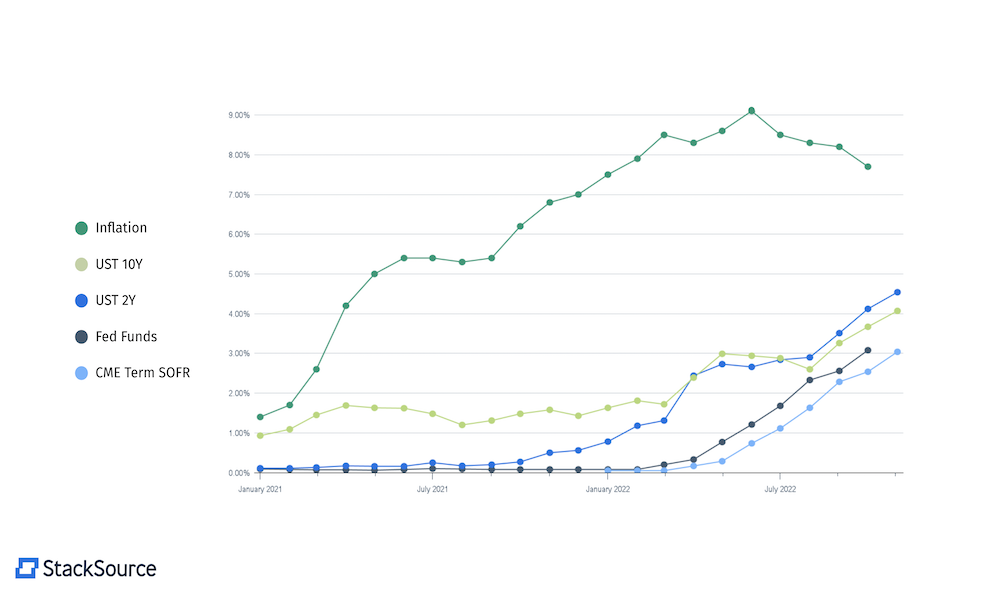Between March and April of 2021, roughly a year after the United States issued lockdown protocols across the country, consumer price inflation increased from less than 3% to more than 4% Year-over-Year. Financial headlines at the time were dominated by words like “Transitory” in trying to grapple with the swift rise up to 7% and beyond in the months that followed.
It wasn’t until early 2022 that the Federal Reserve decided to begin taking action to slow the rise of consumer prices, with inflation peaking around 9% in the late Spring. The Federal Funds rate has climbed from near-zero to 3% over the course of the year, with the market expecting a final 50 basis point hike this week to finish the year at 3.5%.
These economic measures do not impact real estate investments directly. However, the rise in the federal funds rate has correlated with a steep rise in commercial mortgage rates over the course of the year. This has thrown real estate investing metrics for a loop. Higher interest rates impact the value buyers can justify in acquiring a property, as well as the leverage appetite for lenders.
With some lenders sitting on the sidelines, and others moderating their leverage, experienced investors are starting to bring back capital stack strategies that had not been necessary during the cheap money era.
Subordinate financing
The first strategy seeing a big increase in action in today’s market is subordinate financing. This capital strategy brings a second capital source to the deal on top of a senior lender. The most common subordinate financing would be a mezzanine loan (“mezz”). Mezz is generally structured as a loan against the equity in the property, rather than a lien against the property. Another common execution for subordinate financing is receiving preferred equity (“pref”). Negotiations for subordinate financing can be fluid, ending up as either mezz or pref depending on the property’s expected near-term cash flows and the sponsor’s financial picture.
Market participants in this space are a mix of Debt Funds, whose primary capital markets activity has been bridge lending in recent years, and Equity Funds, who have been acquiring properties or making LP equity investments in recent years. The equity funds in this space see mezz and pref equity investing opportunities as an attractive alternative to making LP or JV equity investments at times when commercial property values are in question. The sponsor’s common equity acts as a cushion for the subordinate financier in the case of a dip in value.
Loan assumptions
Many commercial mortgages originated at attractive interest rates in recent years. Now that new loans are quoted at higher interest rates, that creates an incentive to try to take over the current loan during an acquisition deal, rather than originating a new loan. Whether a loan is able to be assumed when a property changes hands is up to the lender as defined in the loan documents. Banks, credit unions, and life insurance companies do not usually allow for loan assumptions, while popular non-recourse lending programs across CMBS, Fannie Mae, and Freddie Mac are usually assumable.
As loan assumptions pick up in popularity, that creates even more space for subordinate financing as well. While the interest rate of an assumed loan may be attractive, it may be low leverage compared to the property’s current value if that value increased since the loan originated.
Government incentive programs
Another avenue to fill a worthy deal’s capital stack is drawing on government incentive programs.
An increasing number of development deals qualify for Commercial Property Assessed Clean Energy (“C-PACE”) financing. C-PACE is a financing program that allows real estate developers to fund energy-saving improvements to properties through long-term, low-interest loans that are repaid through a special assessment on the property’s tax bill. Senior lenders must approve the sponsor’s use C-PACE financing, which makes finding the right senior lender a key piece of employing this type of funding.
Another option is Tax Increment Financing (“TIF”). It is a tool used by local governments to provide incentives for private developers to develop real estate in a specific area. A TIF district allows for a portion of the increased property taxes generated by the new development to be used to help fund additional development, infrastructure, and public services in the area.
Some projects include several tranches of capital between debt, equity, and different government incentives.
If you are a real estate investor or broker that would like a more comprehensive CRE Capital Markets Update, or would like guidance on financing strategy for a particular deal, visit StackSource.com or email Hello@StackSource.com.

